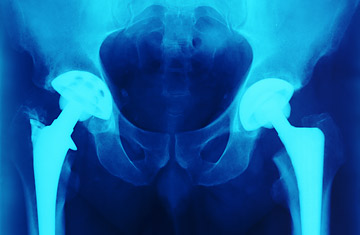
An X-ray of a hip replacement
The number of knee replacements done annually in the U.S. will jump 525% by 2030. You read correctly: 525%. This prediction comes out of a paper presented Thursday at the annual meeting of the American Academy of Orthopaedic Surgeons. Hip replacements? Those will more than double, rising from 285,000 to 573,000. And the money spent on these procedures is expected to reach $65.2 billion by 2015, putting a huge burden on federal Medicare and Medicaid programs, which pay for about 60% of U.S. joint replacements.
It's no surprise that Americans are turning toward these operations — joint replacement has spared millions of older adults from spending their older years in a wheelchair. "We have a perfect storm of an aging population, increased demands by younger patients, a better ability to do the procedure, and increased arthritis in the general population," says Dr. Richard Iorio, a senior orthopedic surgeon at the Lahey Clinic Medical Center in Burlington, Mass., and lead author of the paper. Painful osteoarthritis, he explains, is responsible for the vast majority of joint replacement surgery.
There's another factor contributing to the epidemic of failing joints: obesity. The obese, says Iorio, have twice the rate of hip and knee arthritis as adults with a healthy body weight. Nearly 32% of obese adults have arthritis, as opposed to 16% of those of normal weight and 22% of people who are overweight but not obese.
Iorio says that average age at which Americans seek joint replacements has been gradually creeping down. "In my own practice," he says, "it used to be about 70 years of age, and now it's about 65." With better-lasting implants and better surgical techniques, he observes, "people are much less reluctant to jump in." Changing attitudes will likely accelerate this trend. "Baby boomers want to be active and they are not willing to accept disability, so they seek out surgery earlier than their parents did."
Future patients may, however, be stymied by a shortage of skilled surgeons. The supply of orthopedic surgeons will increase only 2% between 2000 and 2020, despite soaring demand for their services. Patients with more complicated cases, requiring the attention of a joint replacement specialist, could really be in trouble, according to an analysis by Iorio and his co-authors. They found that only 6% to 7% of orthopedic surgeons are specializing in joint replacement. A plummeting reimbursement rate for this kind of surgery — it's dropped about 39% in recent years, according to the paper — makes this kind of work "pretty unappealing to younger surgeons," says Dr. Iorio.
While many people are genetically prone to develop arthritis as they age, there are steps individuals can take to reduce the odds that they will become part of the joint replacement epidemic. Weight control is paramount, says Dr. Joseph Buckwalter, an arthritis specialist at the University of Iowa Medical Center. "For someone who is obese, even losing a relatively little amount — 15 to 20 lbs. — can make a huge difference, both in terms of pain and progression of the disease." For every pound of weight lost, you can take 3 to 5 lbs. of force off a bad joint. Lose 10 pounds, and that's 30 to 50 fewer pounds of force.
Joint injuries earlier life — even in childhood — tend to set people up for arthritis, especially if the injuries aren't treated correctly. "Even a bad ankle sprain could raise the risk of osteoarthritis," says Buckwalter. He therefore advises getting the best possible care after injuring a joint. This can be as basic as resting and icing a sprained ankle or knee and then resuming activity gradually and carefully, starting out with physical therapy, if necessary. "If you have joint injury, make sure that you select activities that don't increase risk. You want to avoid repetitive twisting and pounding."
A third major thing people can do, says Buckwalter, is exercise to maintain muscle strength, range of motion and flexibility, all of which protects the joints. "You need to look at taking care of a vulnerable joint the way you take care of your teeth," he says. Ideally, that means stretching and strengthening muscles on a daily basis. "When my patients say, 'I can't do that,'" he says, "I say, well, you brush your teeth every day."
